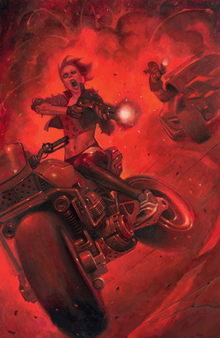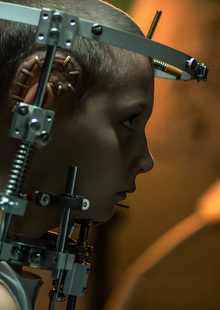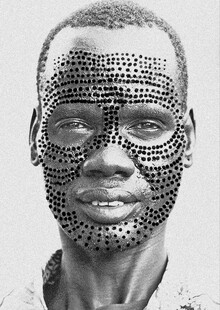
Biblical references and Symbolism in Contemporary Anime and Manga
Outline: Concept Neon Genesis Evangelion Bungou Stray Dogs Fullmetal Alchemist Death Note Devilman Crybaby Trigun Conclusion
Concept
Anime has long been recognized for its ability to explore complex themes and narratives, often drawing from a wide range of social and spiritual topics. Eastern art has become widely popularized in the contemporary world, and due to the broad spectrum of subjects it addresses, anime can rightfully be compared to nearly any theme explored in visual art. Japanese animation and illustration—anime and manga—with their diverse storytelling, frequently draw inspiration from numerous sources, including the Bible. Moreover, given the striking novelty of Christianity as a religion in Japan and the fact that it is practiced by only a small percentage of the population, any references to it in art are clearly deliberate allusions to the Bible.
As one of the enduring sources of inspiration used not only in anime, the Bible serves as a rich repository of universal narratives, moral teachings, and allegorical concepts. Character archetypes drawn from it can be found in nearly every form of contemporary media.
Through a detailed examination of a selected collection of anime and films, this study reveals how biblical styles, concepts, and allegories are reflected in the narratives, characters, and aesthetic elements of contemporary titles popular worldwide.
As a medium, anime encompasses a wide range of styles, including those that provide designers with a foundation for exploring complex visual solutions that align with the narrative. Even within these, Eastern artists often draw inspiration from biblical concepts. By uncovering the nuances of biblical significance in anime, this study highlights the enduring presence of spiritual imagery in contemporary storytelling. The aim of this research is to identify and assess how anime concept designers draw from biblical stories, figures, and styles to create original narratives that resonate with both spiritual and secular audiences.
By analyzing the synergy between Eastern and Western spiritual influences, this study aims to shed light on the broad social and thoughtful implications embedded in these anime works. To conduct this visual analysis, a selection of anime and manga known for their significant and subtle biblical references will be examined. Each chosen title will be thoroughly analyzed for its representation of biblical styles, figures, archetypes, and narratives. Through an evaluation of visual elements, dialogue, plot development, and character traits, this research seeks to illuminate the refined manner in which biblical themes are woven directly into the narrative fabric of anime.
Neon Genesis Evangelion
«God’s in His heaven, all’s right with the world»
One of the most well-known examples of the influence of Scripture in anime, Neon Genesis Evangelion, stands out for its engagement with Christian symbolism intertwined with folklore. This title is remarkably detailed in its commitment to the aesthetic of biblical concepts: from the design of the organization named NERV, whose logo features a fig leaf referencing the story of Adam and Eve, to the angelic beings that allude to biblical angels—its spiritual imagery is interwoven with a complex narrative of existentialism, self-identity, and human struggle.
Bungou Stray Dogs
«Bungou Stray Dogs» is a vast collection of anime, manga, and novels set in the universe created by Kafka Asagiri. Its characters are based on well-known literary figures and their works. However, one particular character frequently and deliberately emphasizes a reference to Christ.
Fyodor Dostoevsky serves as an antagonist who believes himself to be a messenger of God—an idea that, surprisingly, is often reinforced as the plot unfolds. Wine, symbolizing the blood of Christ, frequently appears in association with Fyodor. In Chapter 111, Nikolai asks, «What happened, Dostoevsky? Did you spill your celebratory glass of wine?» when Fyodor is stabbed in a helicopter and blood drips from him. In Chapter 42, a bottle of wine is smashed over Fyodor’s head, running down him like blood.
A frame from the finale of Season 5
At the moment of Fyodor’s death, he utters, «Eli Eli lama sabachthani?”—the final words of Jesus on the cross: Around the ninth hour, Jesus cried out in a loud voice, „Eli, Eli, lama sabachthani?”—which means, „My God, my God, why have you forsaken me?“ —Matthew 27:46 Prior to this, having received three wounds—mirroring Christ—Fyodor is resurrected. This marks the conclusion of the most recent manga chapter released at the time of writing.
Fullmetal Alchemis
«Fullmetal Alchemist» explores themes of sacrifice, redemption, and the consequences of human ambition that resonate with biblical narratives. Edward Elric embodies the archetype of the desired child who seeks to correct past mistakes and attain redemption in a world fraught with ethical ambiguity and profound questions.


A key element of the cross: the crucified serpent
Another memorable biblical symbol is the crucified serpent depicted on the cloak of one of the characters, which also serves as a government seal. This Old Testament symbol (Numbers 21:5-9) represents the moment when Moses saved his people from serpents sent by God as punishment for their unbelief. The bronze serpent on a staff, which heals anyone bitten by simply being looked upon, symbolizes salvation. The character also uses this concept for healing. As a result, the alchemists attempt to assume a god-like role but ultimately fail.
The Copper Serpent (1618–1620) by Anthony van Dyck
«Everything that appeared in consciousness was symbolic symptoms of the unconscious process. If the alchemist managed to form any concrete representation of the contents of his subconscious, he would be forced to admit that he had taken the place of Christ—or, to be more precise, that he saw himself not as the ego, but as himself, assuming the work of redeeming not a man, but God.»
Death Note
The most obvious use of biblical symbolism in this anime is the depiction of the Death Note (the main object of the title) as a bitten apple—representing the act of sin, temptation, and the acquisition of knowledge. Throughout the show, apples frequently appear on screen, often right next to the Death Note. In the Bible, it is said that after Adam bit the apple, he gained the ability to distinguish good from evil. The anime’s plot carries the same meaning: after acquiring the notebook, the protagonist himself decides fate, determining who is good and who is evil.
The anime also features a specific archetype of God who chooses the protagonist. This is where the «chosen one» trope emerges. However, even here, the handing over of the notebook—as a forbidden fruit—comes with a divine warning that it will bring about the protagonist’s downfall.
As the plot progresses, the protagonist becomes blinded by the power granted to him by God and begins to see himself as divine. This is shown in a scene where the protagonist washes the feet of the main hero—mirroring Jesus washing Judas’s feet just before Judas’s betrayal. Judas was Jesus’s disciple, prepared by him to become a good person, just as the protagonist prepared the hero to become the «next one.» In both scenarios, one betrays the other, despite having eaten, drunk, slept, and lived together.
Devilman Crybaby
The modern reinterpretation of Go Nagai’s classic manga, «Devilman Crybaby», explores themes of duality, temptation, and the nature of evil. This series, rooted in Christian folklore, tells the story of Akira Fudo, who, fused with satanic power, becomes Devilman—trapped between the realms of angels and demons. Through its physical imagery and morally complex characters, «Devilman Crybaby» poses profound questions about the nature of sin, redemption, and humanity’s capacity for both good and evil.
One of the archetypes in anime is the literal depiction of Satan as a fallen angel.
The anime features elements from the Book of Revelation (also known as the Apocalypse of John), which are incorporated into the latter half of the series. Akira must battle a massive three-headed demon who temporarily leads the others. In the final confrontation, Satan rides a seven-headed dragon and is depicted as a being of light who deceives people into believing he is good, all while ascending to political power. In his true form, the bizarre arrangement of his wings aligns with biblical accounts: strange events involve the moon, the world is engulfed by a lake of fire, and virtually everyone dies. When the heavens unleash their weapons, they turn people into salt. Human nature itself is depicted as evil and prone to corruption.
Trigun
Trigun is set in a futuristic world inspired by the Wild West and follows the adventures of Vash the Stampede, a notorious bounty hunter with a mysterious past. Trigun weaves biblical themes of mercy, grace, and the struggle between integrity and temptation. Vash, often called the «Humanoid Typhoon,» grapples with self-identity and the consequences of his actions, reflecting biblical stories of repentance and spiritual transformation. Trigun offers profound insights into forgiveness, self-sacrifice, and the pursuit of righteousness in a world trying to impose its will upon you. It is a story less about the battle between good and evil and more about two loving brothers divided in their views on the value of humanity.
The anime features a clearly defined religion and religious symbols.
Anime adaptation 1998
The arrival of evil and suffering in the world in Christianity is called the Fall (the events following the Garden of Eden). In Trigun, there is the Great Fall, which is consistently referenced as the beginning of humanity’s suffering on No Man’s Land—a desert planet closely resembling the biblical Fall.
On the desert planet, the majority of the population appears to practice Christianity. They wear crosses, churches line the streets, and priests are recognized. This allows Yasuhiro Nightow to emulate the style of Western films and TV shows that presumably inspired the anime, such as Pale Rider or The Quick and the Dead. Orphanages are located within churches, and desperate people both follow—and reject—the Ten Commandments. Even Milly Thompson (the protagonist’s friend) spends much of the Trigun Maximum season wearing clothing adorned with Greek crosses, although most episodes feature the Latin cross.
Chirches in manga
The religious inclinations of the planet’s inhabitants are mentioned less frequently in the anime than in the manga. However, the anime features a unique song by Rem titled «Sound Life, ” which recounts the planet’s earliest days in a style reminiscent of the creation myth from the Book of Genesis.
In Episode 3 of the new Trigun Stampede series, Knives (the protagonist’s brother) recounts a story about God. He recalls the tale of Sodom and Gomorrah, saying, «Once God rained fire from the heavens to destroy the depraved city of fools and create a righteous world.»
In the story above, Knives places himself in the role of the Old Testament God who flooded the earth to cleanse it, destroyed Sodom and Gomorrah, and expelled humanity from the Garden of Eden. Even in pre-Stampede Trigun, he appears to see God—and himself—as a judge destined to purge the world of sinners and corrupt fools according to his own judgment. In contrast, Vash resembles Jesus, who pleads for the salvation of humanity: «They know not what they do.»
The «Eye of Michael» (almost certainly named after the Archangel Michael, referenced in Jewish, Christian, and Islamic sacred texts) is an assassin organization founded by the leader of a church that worships the Stations.
Manga illustration
The first volume of the manga introduces the Stations. They provide people with everything they need, and their appearance is compared to angels—messengers of God. Both the protagonist and his brother are Stations themselves. Biblical angels are known for appearing before people and saying «Do not be afraid» to comfort the shaken. In Volume 11, the phrase «Be very afraid. You are in his presence» is used referring to the protagonist’s brother. This same character quotes the Bible extensively: «Thy will be done» (from Matthew 6:10, «Thy kingdom come, Thy will be done on earth as it is in heaven»), and «born again» (from the Gospel of John 3:3, where Jesus replies, «Truly, truly, I say to you, unless one is born again, he cannot see the kingdom of God»).
Trigun Maximum Chapter 46 — The Ark
Using the same character, Knives isolates Vash and lures him into a trap aboard a ship that Knives unknowingly calls the «Ark.» At this point, he begins his pilgrimage to gather all the Stations on the planet, freeing them from human slavery. Without the Stations, the people of No Man’s Land will perish. With the Ark, Knives orchestrates his own flood, depriving the planet’s inhabitants of water and food. (Genesis 6:13–14, «And God said to Noah, ‘I am going to destroy all people, for the earth is filled with violence because of them. I will surely wipe them and the earth out. So make yourself an ark of cypress wood […]’)
Eden (2023 adaptation)
The new adaptation, Trigun: Stampede, retains the key plot concepts that referenced the Bible in the original anime: ships as the Garden of Eden from which Vash and Knives were «expelled» for learning what they were not meant to know; No Man’s Land as the desert where Jesus wandered; and the overall Christian themes. However, some elements have become even more explicit. At the very beginning of the anime, Knives literally reads the Bible, and by the end, during the apocalypse, he says, «Let the human empire turn to salt.» At the same time, he kills Vash with the words, «Then be crucified for these sinners, ” and afterward, Vash is resurrected when found by his friend Meryl—an allusion to Christ’s resurrection and that the first to encounter him was Mary.
A frame from the 2023 adaptation: The gates behind Vash also take a shape associated with divinity. In Christianity, this would be the Uncreated Light of Christ (Tabor Light) in iconography
Conclusion
This visual study examines the various ways anime incorporates biblical allegories directly into its stories, characters, and aesthetic imagery. From simple symbols to profound references, anime offers a powerful overview that reveals timeless motifs intertwined with universal truths embedded in spiritual messages. By uniting Eastern and Western spiritual practices, anime transcends social boundaries, inviting viewers to contemplate the much deeper mysteries underlying human struggles.
The Brazen Serpent. Museo Nacional del Prado — Сайт — URL: https://www.museodelprado.es/en/the-collection/art-work/the-brazen-serpent/4bc2120c-fa25-4b35-af7c-dda70e463a0d?searchid=fe7ea9bd-d5d4-b67f-5ecb-750f4d6625ec
Выдержки из «Психологии и алхимии» Карла Юнга. carljungdepthpsychologysite — Сайт — URL: https://carljungdepthpsychologysite.blog//05//alchemy-by-carl-jung/
ESSAY: Finding God in No Man’s Land — Christian Influence in Trigun. womenwriteaboutcomics.com — Сайт — URL: https://womenwriteaboutcomics.com/2023/04/essay-finding-god-in-no-mans-land-christian-influence-in-trigun/



